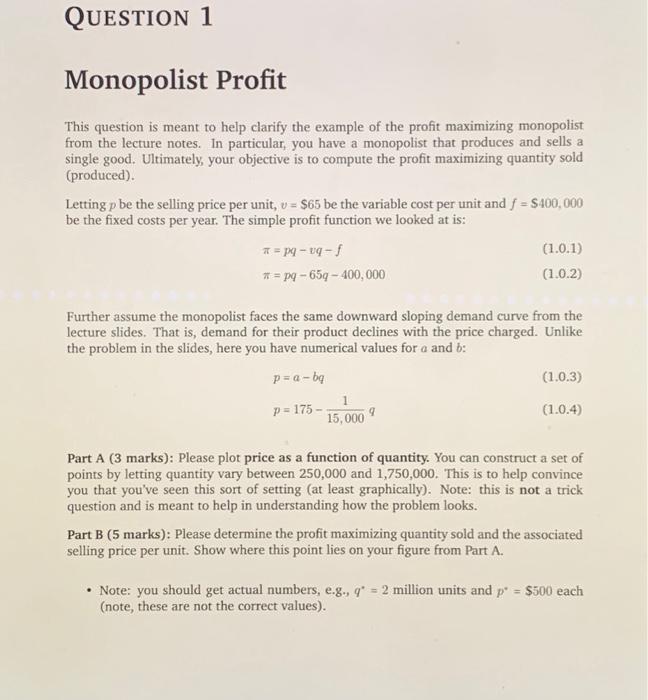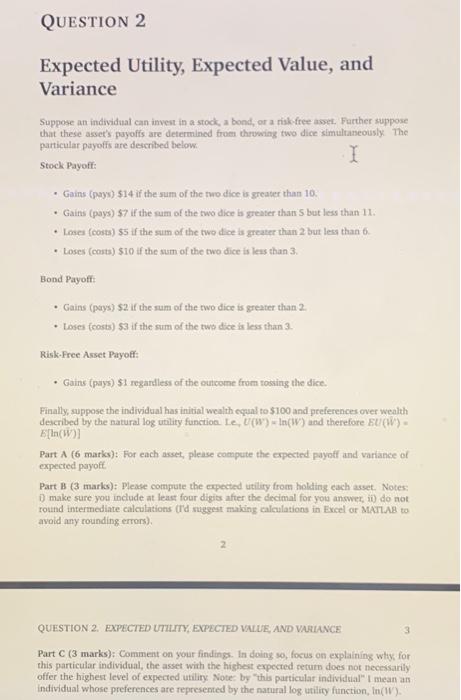This question is meant to help clarify the example of the profit maximizing monopolist from the lecture notes. In particular, you have a monopolist that produces and sells a single good. Ultimately, your objective is to compute the profit maximizing quantity sold (produced). Letting p be the selling price per unit, v=$65 be the variable cost per unit and f=$400,000 be the fixed costs per year. The simple profit function we looked at is: =pqvqf=pq65q400,000 Further assume the monopolist faces the same downward sloping demand curve from the lecture slides. That is, demand for their product declines with the price charged. Unlike the problem in the slides, here you have numerical values for a and b : p=abqp=17515,0001q Part A (3 marks): Please plot price as a function of quantity. You can construct a set of points by letting quantity vary between 250,000 and 1,750,000. This is to help convince you that you've seen this sort of setting (at least graphically). Note: this is not a trick question and is meant to help in understanding how the problem looks. Part B (5 marks): Please determine the profit maximizing quantity sold and the associated selling price per unit. Show where this point lies on your figure from Part A. - Note: you should get actual numbers, e.g., q=2 million units and p=$500 each (note, these are not the correct values). Expected Utility, Expected Value, and Variance Suppose an individual can invent in a stock, a bond, or a risk-free aset. Further suppose that these asset's payoffs are determined from throwing two dice simultaneously The particutar payoffi are descritied betow: Stock Payoff: - Gains (pays) $14 if the sum of the tro dice is greater than 10. - Gains (pays) $7 if the sum of the two dice is greater than 5 but less than 11. - Loses (costs) $5 if the sum of the two dice is greater than 2 but less than 6 . - Loses (costa) $10 if the sum of the two dice is less than 3. Bond Payoft: - Gains (pays) $2 if the rum of the two dice is greater than 2. - Loses (costs) 53 if the sam of the two dice is less than 3. Risk-Free Asset Payoff: - Gains (pays) 51 regartless of the ouncome from tossing the dike. Finally, suppose the individual has initial wealth equal to $100 and preferences over wealth described by the natural log utility function. Le, U(W)=ln(W) and therefore EU(W). xith (iin) Part A (6 marks): For each asset, please compute the expected payoff and variance of expected payoff. Part B ( 3 marks): Please compute the expected utiliry from holaing each asset. Notes: D) make sure you include at leas four digits after the decimal for you answex, ii) do not round intermediate caleulations (T)d mugest making calculations in Excel or MATH.A8 to avoid any rounding errors). 2 QUESTION 2. EXPECTED UTHITY, BXPECTED VAUE, AND VARUNCE 3 Part C (3 marks): Comment on your findings. In doing so, focus on explatring why, for this particular individual, the asset with the highest expected seturn does not necossarily offer the highest level of expected utility Note: by "this particular individual" I mean an individual whose preferences are represented by the narural log utility function, ln(1V)








